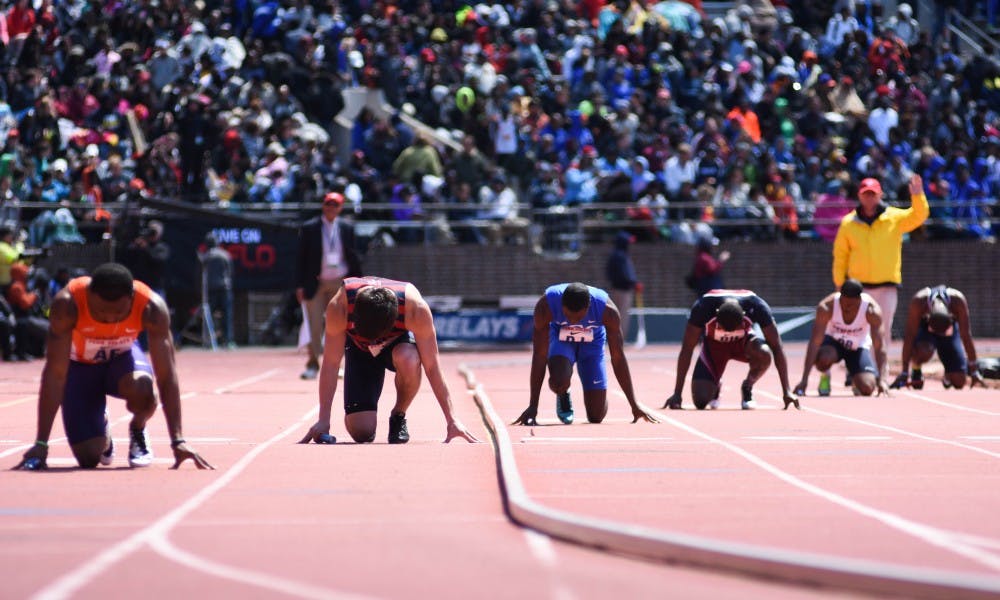The runners have taken their places. It’s a beautiful, sunny Saturday in April, and the competitors are lined up in front of a crowd of over 40,000 at Franklin Field. For some, this may be the biggest race of their lives. The nerves are building, and the tension becomes thicker and thicker in the air.
Finally, the starting gun sounds.
For many track and field athletes — high school, college and professional — the Penn Relays is the one of the most prestigious and highly anticipated competitions of the year. More athletes compete in the Relays than the Olympics; with over 22,000 participants and in excess of 100,000 spectators over the course of three days, in addition to countless volunteer staff and security, it is undoubtedly the biggest Penn-sponsored event of the year.
But how is a spectacle of this magnitude produced? We know the athletes train year-round on the track and in the weight room, but so much more goes into the event than just the athletic training. Where do the athletes stay? How are tickets distributed? Which colleges and professionals come to compete? How is the event reported?
That’s where the Penn Relays staff comes in. Though the vast majority of people working for the Relays are volunteers, a small contingent of Penn Athletics staff dedicates themselves to the event almost year round, and almost every one of them has at least a decade of experience.
In charge of it all is Director Dave Johnson. The upcoming Relays will be Johnson’s 21st as director, though he had plenty of experience with the Relays before assuming his current position; the first year he ever worked with the Relays was 1978.
As director, Johnson has a stake in all of the different logistical aspects of the Relays — from ticketing to security to press coverage, he must be aware of the workings of every department, as one might expect. Moreover, Johnson is ultimately in charge of troubleshooting event-wide issues.
“You get hit with odd questions and you find out all sorts of weird things,” he said. “I’ve had to learn about all sorts of things I thought I had no interest in — Philadelphia traffic patterns, railroad work on SEPTA lines, the effect of the Philadelphia Flower Show on the Relays — just seeing how all sorts of pieces of the city interrelate.”
Issues that come up vary widely in size and scope. Sometimes the challenges are of the more normal variety, such as issues with result accuracy or inclement weather. Other times, however, one change of plans on the other side of the city can affect the entire Relays. For example, a flight cancellation one year meant that Johnson and the rest of the Penn staff had to organize extra hotel arrangements for a group of teams from the Carolinas, the cost of which had to be partially covered by the Relays.
One of the biggest challenges of the job, however, is dealing with the sheer number of people that are involved in the Relays. Most of the events happening at Penn fit within the Penn bubble. The Relays, however, meet a much wider audience and are contingent upon the participation of so many people outside of the Penn community for which Johnson is ultimately responsible.
“Because it’s a public event, my constituency group is not internal like it is for coaches or administrators. It’s out in the rest of the world,” he said. “A coach has other coaches within the sport that are his peer group; their responsibility group is more restrained. My responsibility group is the volunteers, the officials, the coaches, the spectators — everyone. I’m reaching outside the track and field community and Penn community more than I am internally.”
Joining Johnson in his meticulous planning efforts are Assistant Director Gail Zachary and Staff Assistant Norm Lieberman. Like Johnson, both Zachary and Lieberman have decades of experience and have duties that expand over nearly every facet of the Relays, from settling contracts with hotels throughout Philadelphia to making sure there is adequate lodging for athletes and spectators to making sure officials are in the right places at the right times.
“With the Relays, I’m involved in basically every stage. I have a concept of what our hospitality crew is doing, what’s happening with catering, dealing with colleges and their requests. Ticketing, fee collecting, apparel and uniforms, so coordinating everything to make sure everything is where we need to be when Thursday morning arrives,” Zachary said.
While the staff is in charge of the planning and coordinating of all of these aspects of the events, they ultimately rely on volunteers to do their jobs on the ground. Other than paid workers, which involve security, officials, police, vendors, and others, the Penn Relays rely on about 600 volunteers each year to come and make sure everything runs smoothly.
“Luckily, as an event, we have a lot of loyalty,” Zachary said. “People enjoy coming here and working here. It’s almost like a once-a-year reunion for the officials and the fans and the athletes. So it’s important to a lot of different people.”
An event with the prestige and scope of the Penn Relays obviously attracts a lot of media attention. Enter Chas Dorman.
Dorman, entering his ninth year working for the event, is the associate director of Penn’s athletic communications department and acts as the media relations coordinator for the Penn Relays. With over 400 local, regional and national journalists coming to cover the event, the Penn Relays are easily Dorman’s biggest event of the year.
“The biggest challenge is staying engaged over the entire length of the race days,” Dorman said. “We’ve got races from 10 AM till 11:30 PM if everything is on schedule, which means I need to be here at around 5:30 AM to set up the media room, so we have to be ready and chipper and happy at 6 AM. If the races are on schedule, then I leave at 1 AM, and then we do it all over again the next day. There are years that we’ve started races at 1 AM. But journalists are here to cover these events, so we have to have the media room available.”
The biggest thing that Dorman stresses, however, is the spectacle of the Relays. Some athletes are high schoolers for whom this will be the biggest event of their careers; others are prospective Olympians whose performance at the Relays could affect their inclusion in the Games. All of this divides one large competition into many small segments, each segment being the most important of the Relays for someone there.
“We have Olympians, we have high schoolers, we have World Champions and we have 95 year olds. There’s so much going on that every time the starting gun goes off — that’s a big moment for those people, so there’s no down time,” Dorman said. “Along with that, there are media members here who don’t cover an ounce of track. They’re here to engage with the fans and show off the cultural aspect of this event, to document what this experience is like for everyone.
"That’s one of the biggest things I learned early in my time with the Relays. This isn’t just a track meet. So I have to know how I can help them cover that too.”
This sentiment is echoed by Dipen Shah, who graduated from Penn as part of the Class of 2000 and is in charge of technology for the Relays. Shah started working for the Relays as a work-study job when he was enrolled and has been involved with the event ever since. With the volume of races that occurring over the course of the event, Shah has been working year after year to improve computer interface to condense results and make them more easily available to the public. When the timers send the results to Shah and his staff, it only takes an extra tenth of a second for the times to go online once they appear on the scoreboard.
Furthermore, the data is grouped on an easy to use website that groups competitors and schools by event and by region, making it easier than ever for fans and journalists to get the information they want about a certain competitor or team. Over the past few years, they’ve included quote and picture features that are tagged with each team and individual, adding to the fan-friendly experience of the Relays. Over the three days, the system receives about a terabyte of just photo data, or close to 35,000 pictures.
“The original goal of the program was to collect data for teams so that journalists could more easily find a story to write about,” Shah said. “We have information broken down by conference, by state, by region, so that all of the different media members that are here can more easily find a story that relates to them. But at the end of the day, we’re trying make this a better experience for the athletes and the fans.”
One sentiment that was shared by everyone on the staff was the sense of community that comes with working on the Relays. With almost every position being volunteer, people contribute their time to the event because they love it.
“They come, they spend their time, and they work hard,” Shah said. “Those are the people that really make it all come together.”
For the fans and the athletes, the Penn Relays is more than just another track and field competition. It’s one of the biggest events of the year, not just at Penn but in all of Philadelphia, and it shows in the passion with which the Relay staff works.









